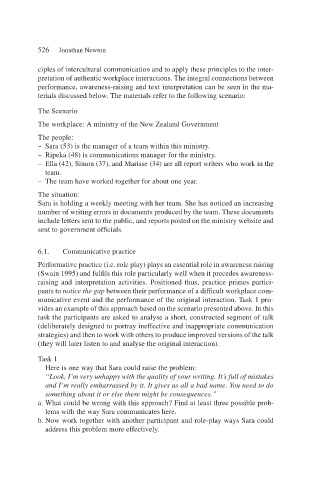Page 548 - Handbooks of Applied Linguistics Communication Competence Language and Communication Problems Practical Solutions
P. 548
526 Jonathan Newton
ciples of intercultural communication and to apply these principles to the inter-
pretation of authentic workplace interactions. The integral connections between
performance, awareness-raising and text interpretation can be seen in the ma-
terials discussed below. The materials refer to the following scenario:
The Scenario
The workplace: A ministry of the New Zealand Government
The people:
– Sara (53) is the manager of a team within this ministry.
– Ripeka (48) is communications manager for the ministry.
– Ella (42), Simon (37), and Marisse (34) are all report writers who work in the
team.
– The team have worked together for about one year.
The situation:
Sara is holding a weekly meeting with her team. She has noticed an increasing
number of writing errors in documents produced by the team. These documents
include letters sent to the public, and reports posted on the ministry website and
sent to government officials.
6.1. Communicative practice
Performative practice (i.e. role play) plays an essential role in awareness raising
(Swain 1995) and fulfils this role particularly well when it precedes awareness-
raising and interpretation activities. Positioned thus, practice primes partici-
pants to notice the gap between their performance of a difficult workplace com-
municative event and the performance of the original interaction. Task 1 pro-
vides an example of this approach based on the scenario presented above. In this
task the participants are asked to analyse a short, constructed segment of talk
(deliberately designed to portray ineffective and inappropriate communication
strategies) and then to work with others to produce improved versions of the talk
(they will later listen to and analyse the original interaction).
Task 1
Here is one way that Sara could raise the problem:
“Look, I’m very unhappy with the quality of your writing. It’s full of mistakes
and I’m really embarrassed by it. It gives us all a bad name. You need to do
something about it or else there might be consequences.”
a. What could be wrong with this approach? Find at least three possible prob-
lems with the way Sara communicates here.
b. Now work together with another participant and role-play ways Sara could
address this problem more effectively.

